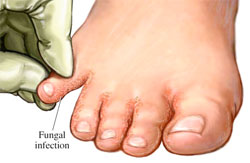Fungal Infections

Athletes foot
What is it? Athlete’s foot is a intense itching, cracked, blistered or peeling areas of skin, redness and scaling. It can occur on moist, waterlogged skin especially between the fourth and fifth toes, or on dry, flaky skin around the heels or elsewhere on the foot.
What causes it? It’s caused by a number of fungal species which you can pick up from anywhere (typically communal areas such as pools, showers and changing rooms) or anywhere where you may walk around barefooted, “The fungus on each bit of skin that falls away from someone else’s feet can be picked up by you if you’re prone.” Once your feet have been contaminated, the warm, dark and sweaty environment of feet cramped in shoes or trainers provides the ideal breeding ground for the fungus. However, athlete’s foot also occurs in dry, flaky areas. It’s quite common in summer sandal-wearers. The sun makes your skin dry out, so it loses its natural protective oils; this combined with the constant trauma from sandals makes them more prone to infection.
Who gets it? Well, it’s not called athlete’s foot for nothing. Walking barefoot around swimming pools and spending your life in trainers make you more likely to suffer. But obviously, you don’t need to be an athlete to suffer.
Is it serious? If left untreated, the fungus can spread to the toe nails, causing thickening and yellowing of the nail, which is much harder to trea. Fungal infections are highly contagious and can spread to anywhere on your skin – to your scalp, hands and even your groin, especially if you use the same towel for your feet as for the rest of your body
What can I do? There are many things you can do to make your feet less hospitable to fungal infections:
For athlete’s foot where the skin conditions are dry If your athlete’s foot occurs on a dry area such as your heel, you need to restore moisture by rubbing in an anti-fungal cream or ointment. However, don’t forget to wash your hands thoroughly afterwards. Even better, use disposable gloves so you don’t get the fungus on your hands at all.
What can a podiatrist do? A podiatrist can help you pinpoint the best treatment for your particular type of athlete’s foot. Your podiatrist can also help if the fungal infection has spread to your nails, by reducing the thickness and cutting back the nails, thereby exposing the infected nailbed to a lighter, cooler environment. If the fungus is only in the nail and not elsewhere, it is probably caused by an injury. An injury allows the fungus to creep in and multiply under the nail. This can affect the substance of the nail which may become crusty, discoloured and deformed.
